Discover 11 hidden attractions, cool sights, and unusual things to do in Yaroslavl (Russia). Don't miss out on these must-see attractions: Ascension Church, St. John the Baptist Church, and Eternal flame. Also, be sure to include Uspenskiy Kafedral'nyy Sobor in your itinerary.
Below, you can find the list of the most amazing places you should visit in Yaroslavl (Yaroslavl).
Table of Contents
Ascension Church
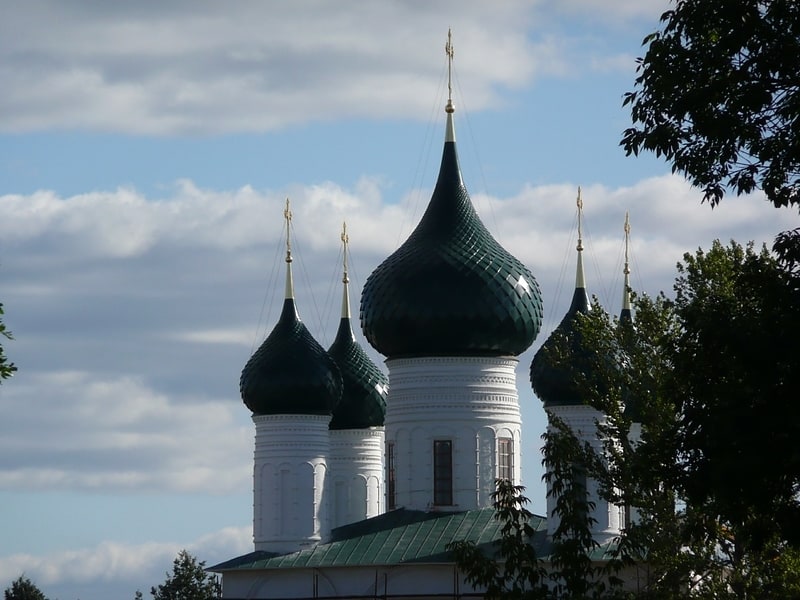
Also known as: Вознесенско-Сретенский приход
The Church of the Ascension of Christ is a four-piered penticupolar Orthodox church erected in Kondakovo, a western suburb of Yaroslavl between 1677 and 1682.
The first church on the site was commissioned in 1584 by Basil Kondaki, a wealthy Greek merchant, in order to prevent the planned construction of a Lutheran church in Kondakovo. A smaller parish church is dedicated to the Presentation of Jesus at the Temple. This late Baroque building incorporates the 17th-century refectory, a survival from an earlier church. A belfry dating from 1745 was demolished in the 20th century.
The parish churches sustained damage in the Yaroslavl Revolt of 1918 and were later adapted for use by a nearby car barn. The larger church, with all the domes taken down, was used as a depot. Aleksey Soplyakov's frescoes from 1736 have all but disappeared. It was not until the late 2000s that the buildings were returned to the Russian Orthodox Church and restoration work began.[1]
St. John the Baptist Church

Also known as: Церковь Иоанна Предтечи в Толчкове
Iconic church depicted on currency. St. John the Baptist Church in Yaroslavl is considered to be the acme of the Yaroslavl school of architecture. It was built during 1671–1687 on the bank of Kotorosl river in the Tolchkovo sloboda which at that time was the largest and wealthiest part of the town.
Its walls and dome drums are covered with richly glazed tiles; the temple's fifteen onion domes are assembled in three groups. The 7-storey, 45-metre high bell-tower was built later than the church itself in mid-1690s.
The entire interior is covered with frescoes depicting Christian saints, St. John the Baptist hagiography and biblical topics. They were painted by Dmitry Plekhanov and Fyodor Ignatyev in 1694–1695. In 1911, patrimonial defensor Nicholas Roerich wrote Silent Pogrom about the unskillful restoration of the church after the Russian-Japanese war of 1904–1905.[2]
Address: 2-я Закоторосльная наб., 69, 150001 Yaroslavl'
Eternal flame
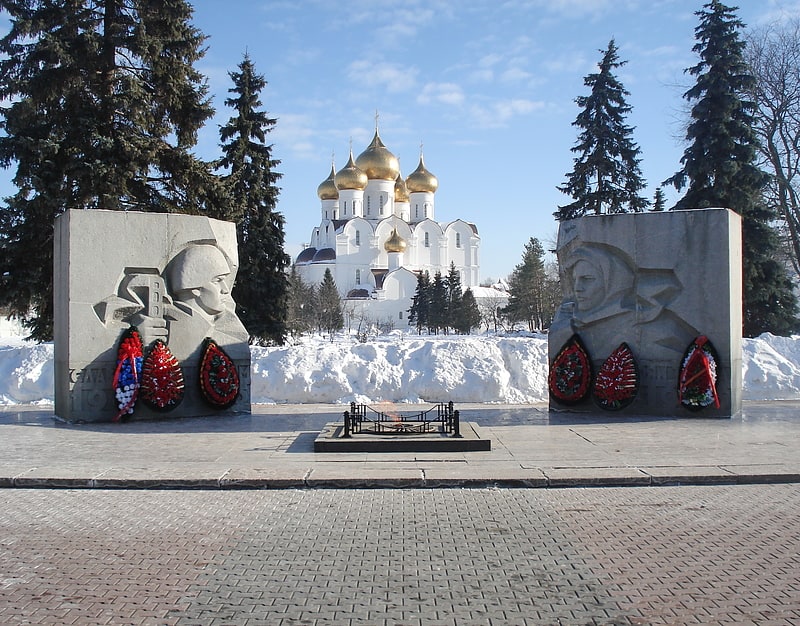
The Eternal Flame Monument is a monument in Yaroslavl in honor of the military and labor glory of Yaroslavl residents during the Great Patriotic War of 1941-1945. It is located in the historic center of the city on Chelyuskintsev Square.
Uspenskiy Kafedral'nyy Sobor
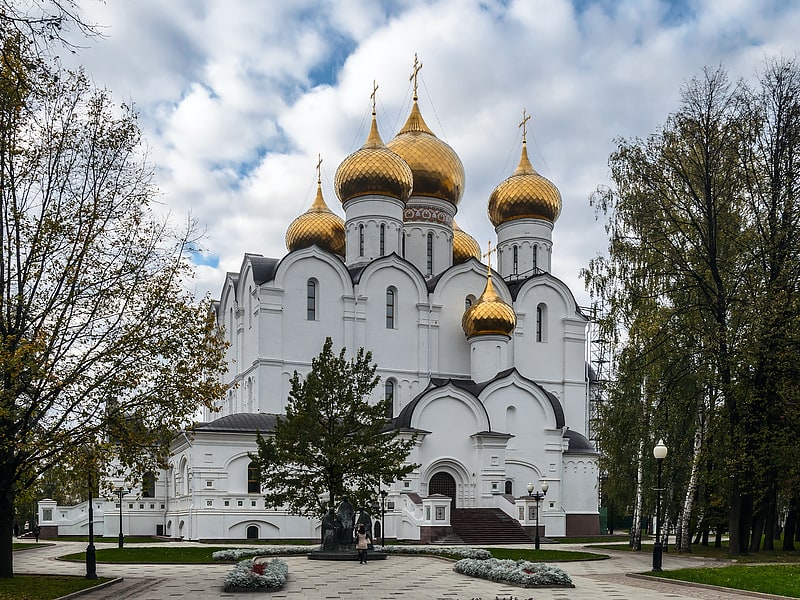
The Council of Dormition of the Mother of God - the Council in Jarosław, erected in 1219, served from 1788 to the destruction in 1937 as the cathedral of the Jarosław and Rostowska Eparchy. The building was located near the so -called "Arrows" - the mouth of Kotorosli to the Volga.
The current facility was built in a new form after 2004. It is different from the previous size. He plays the role of the Jarosław Eparchy Department.
Spaso-Preobrazhenskiy Muzhskoy Monastyr'
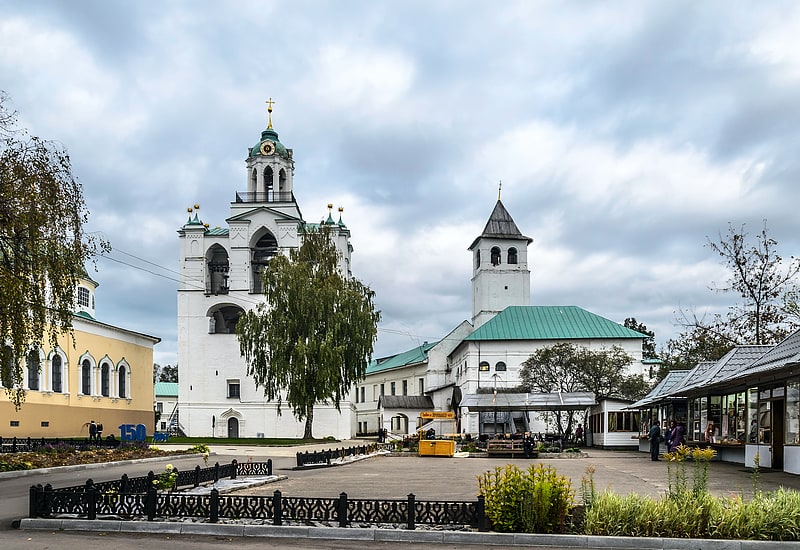
Yaroslavl Spaso-Preobrazhensky Monastery is an ancient abolished male monastery in Yaroslavl, which played an important role in local history. It was founded by Prince Konstantin Vsevolodovich in 1216. It is located in the historic center of the city, on the bank of the Kotorosl river. On its territory there are monuments of architecture of the XVI-XIX centuries. Here was found a list of "The Tale of Igor's Campaign" - a monument of ancient Russian literature.
Church of Saint Nicetas
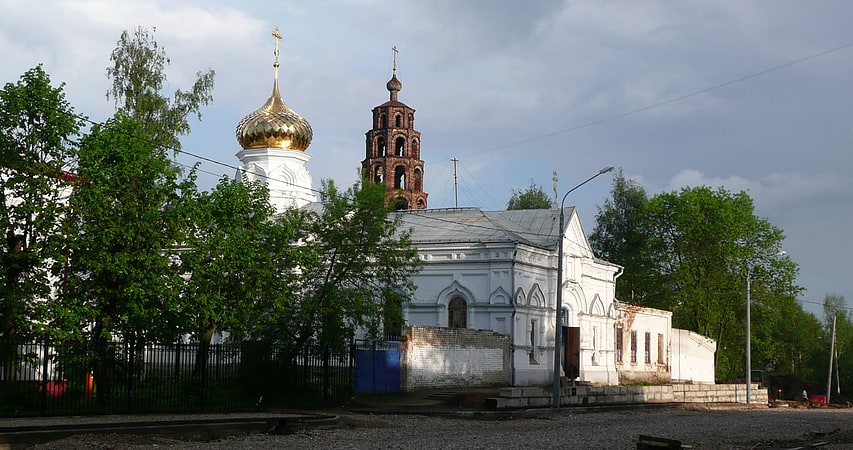
Also known as: Никитско-Сретенский приход
Church. The Church of St. Nicetas is a Russian Orthodox church of St. Nicetas the Goth on Victory Street in Yaroslavl. It used to be the parish church of medieval Nikitskaya sloboda.
The wooden church of St. Nicetas is known to have existed in 1511. It was rebuilt in stone in 1647 but remained one of the town's poorest churches through much of its history. Its main treasure was the large 16th-century icon of St. Nicetas, currently on exhibit in a local art gallery. After the Russian Revolution the church was closed and dismantled. Some of the frescoes were taken down to be sold abroad. Its remarkable bell tower, built at some point during Peter the Great's reign, still stands. The Soviets classed it as an object of top military importance because of its considerable height.
The parish of St. Nicetas also had a smaller church for winter services. It was consecrated to the Presentation of Jesus at the Temple in 1670. By the early 20th century, the building had proved too small for crowds of factory workers and was considerably expanded in a rather plain Russian Revival style. The domeless building was lucky to survive the Soviet period and has been renovated since 1997.[3]
Address: Pobedy, 49, 150014 Yaroslavl
Damanskiy bridge

The bridge to Damansky Island is an automobile and pedestrian bridge over the Kotorosl in the central part of Yaroslavl. It connects Podzelenie Street with Damansky Island, where the city amusement park is located.
The bridge to Damansky Island is one of the places where weddings are celebrated in Yaroslavl: traditionally, the groom carries the bride across the bridge, and on its fence secures the "love lock".
Fyodorovskaya Church

Also known as: Фёдоровская церковь
Church in Yaroslavl, Russia. The Fyodorovskaya Church is a penticupolar parish Russian Orthodox church built by ordinary parishioners on the right bank of the Kotorosl River in Yaroslavl between 1682 and 1687. It is dedicated to Theotokos Feodorovskaya, a miraculous icon from nearby Kostroma.
The building is notable as the first church in the region to be returned by the Soviets to the Russian Orthodox Church. It served as the cathedral church of the ancient Yaroslavl-Rostov eparchy until the restored Dormition Cathedral was consecrated in 2010. During this period the relics of St. Theodore the Black and other local saints were kept there.[4]
Muzej istorii goroda Aroslavla

Yaroslavl City History Museum is a museum in the city of Yaroslavl dedicated to its history.
Address: Волжская набережная, 17, Yaroslavl
Aroslavskij muzej-zapovednik
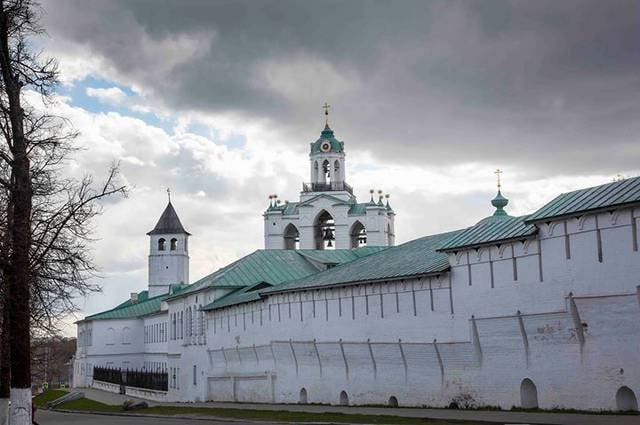
Museum
Address: Богоявленская пл., 25, Yaroslavl
Museum of old Russian art

Metropolitan Chambers is one of the oldest surviving monuments of civil architecture in the city of Yaroslavl.
Address: Volzhskaya Emb., 1, 150000 Yaroslavl